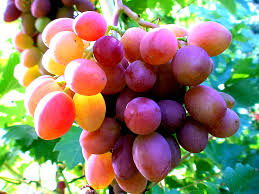 If you eat grapes regularly, chances are you are healthier than people who don’t. A new observational study, published in the Journal of Food Science, showed an association between grape consumption – including fresh grapes, raisins and 100 percent grape juice – and healthier dietary patterns and nutrient intakes.
If you eat grapes regularly, chances are you are healthier than people who don’t. A new observational study, published in the Journal of Food Science, showed an association between grape consumption – including fresh grapes, raisins and 100 percent grape juice – and healthier dietary patterns and nutrient intakes.
By analyzing the diets of more than 221,800 children and adults using data from the 2003-2008 National Health and Nutrition Examination Survey, researchers found people who consumed grapes and grape products had increased levels of vitamin A, vitamin C, vitamin B6, dietary fiber, calcium and potassium.
It was found those who eat grapes also eat more of other fruits, vegetables, whole grains, nuts and seeds than non-consumers. They also consumed less added sugar, total fat, saturated fat and cholesterol.
Jean-Mari Peltier, Executive Director of the National Grape and Wine Initiative said, “It reinforces the association between grapes and a healthier diet, which is good news for consumers. Grapes, raisins and 100% grape juice are all foods that people enjoy eating, and this information adds another dimension to the grape and health story.”
Grapes are part of the berry family that have been eaten as food for over 2000 years. A three-quarter cup serving of grapes (red, green, or black) provides 90 calories, 23 g total carbohydrates, 1 g dietary fiber, and 20 g sugar. A one-quarter cup serving of raisins provides 120 calories, 1 g protein, 32 g total carbohydrate, 2 g dietary fiber, and 24 g sugar. Eight fluid ounces of 100 percent grape juice contains 150 calories, 1 g protein, 37 g total carbohydrate, and 36 g sugar.
Grapes, raisins, and grape juice also contain a wide variety of polyphenols, which may have beneficial effects on health. The biomedical effects of grape products have recently been reviewed and include modulating endothelial function, delaying low-density lipoprotein (LDL) oxidation, lowering blood pressure, and reducing oxidative stress, along with having beneficial effects on immune markers and cognition.
The dietary pattern reported by grape eaters in this study is similar to the pattern recommended by current dietary guidelines which include increased intakes of fruit and vegetables, especially dark green and orange vegetables, and reduced intakes of sodium, fat, added sugars, and calories from solid fats and added sugars. Fruit product intake has previously been associated with healthier dietary patterns. Significantly higher scores on the 2005 Healthy Eating Index have been associated, for instance, with 100 percent orange juice consumption by children and dried fruit consumption by adults.
Grapes are America’s number one specialty crop. The National Grape and Wine Initiative focuses on research and extension to strengthen the US grape and grape product industries in partnership with academics and government.
 Dzobak Volodymyr
РОЗДУМИ ПРО НАДВАЖЛИВЕ або ЧОМУ НАШІ ОЛІГАРХИ СТАЛИ МОГИЛЬЩИКАМИ НИНІШНЬОЇ УКРАЇНИ
Dzobak Volodymyr
РОЗДУМИ ПРО НАДВАЖЛИВЕ або ЧОМУ НАШІ ОЛІГАРХИ СТАЛИ МОГИЛЬЩИКАМИ НИНІШНЬОЇ УКРАЇНИ




 If you eat grapes regularly, chances are you are healthier than people who don’t. A new observational study, published in the Journal of Food Science, showed an association between grape consumption – including fresh grapes, raisins and 100 percent grape juice – and healthier dietary patterns and nutrient intakes.
If you eat grapes regularly, chances are you are healthier than people who don’t. A new observational study, published in the Journal of Food Science, showed an association between grape consumption – including fresh grapes, raisins and 100 percent grape juice – and healthier dietary patterns and nutrient intakes.